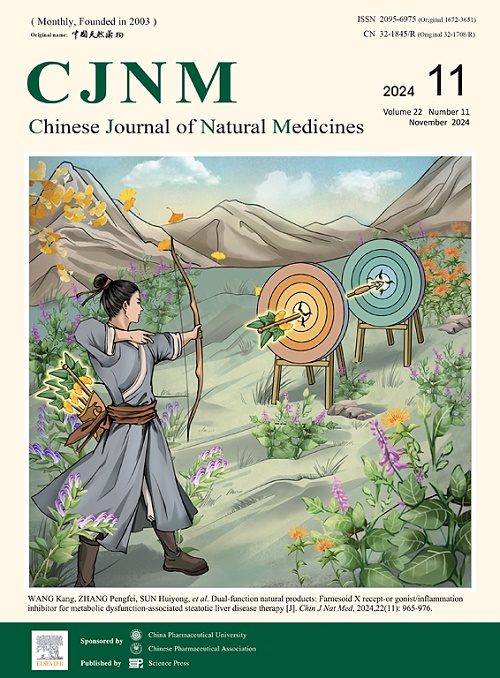肝损伤下药物转运体器官间相互作用的新证据
IF 4.9
2区 医学
Q1 INTEGRATIVE & COMPLEMENTARY MEDICINE
引用次数: 0
摘要
肝损伤患者药物转运体功能障碍显著影响治疗效果和药物疗效。临床和实验证据表明,肝损伤涉及脑、眼、肝、肠和肾之间复杂的器官间相互作用。基础和临床研究的最新进展揭示了肝损伤中转运蛋白改变的生理和分子机制,特别是与胆红素、活性氧、氨、胆汁酸和炎症因子相关的转运蛋白改变。值得注意的是,这些转运蛋白修饰对肝损伤患者药物药代动力学的影响尚不清楚。进一步的研究是必要的,以充分了解这些影响及其治疗意义。各种肝脏疾病的远端器官中转运蛋白的改变表明,在对肝功能障碍患者使用转运蛋白底物药物(包括中西医药物)时,可能需要改变剂量。这种策略有助于将药物浓度维持在治疗范围内,同时减少不良反应。此外,在临床上使用转运体诱导剂或抑制剂时,必须考虑它们对转运体的长期影响和随后的治疗效果。当抑制这些转运蛋白时,必须仔细注意避免损害有毒代谢物和蛋白质的消除。同样,谨慎使用诱导剂或诱导剂型治疗药物是必要的,以防止增强耐药性。本文综述了肝损伤条件下药物转运体的器官间相互作用及其临床相关性的最新临床和实验发现。本文章由计算机程序翻译,如有差异,请以英文原文为准。
Emerging evidence of inter-organ interaction on drug transporters under liver injury
Dysfunction of drug transporters significantly affects therapeutic outcomes and drug efficacy in patients with liver injury. Clinical and experimental evidence demonstrates that liver injury involves complex inter-organ interactions among the brain, eye, liver, intestine, and kidney. Recent advances in basic and clinical research have illuminated the physiologic and molecular mechanisms underlying transporter alterations in liver injury, particularly those associated with bilirubin, reactive oxygen species, ammonia, bile acid, and inflammatory factors. Notably, the influence of these transporter modifications on drug pharmacokinetics in liver injury patients remains inadequately understood. Additional research is necessary to fully comprehend these effects and their therapeutic implications. The documented alterations of transporters in distant organs across various liver diseases indicate that dosage modifications may be required when administering transporter-substrate drugs, including both traditional Chinese and Western medicines, to patients with liver dysfunction. This strategy helps maintain drug concentrations within therapeutic ranges while reducing adverse reactions. Furthermore, when utilizing transporter inducers or inhibitors clinically, consideration of their long-term effects on transporters and subsequent therapeutic impact is essential. Careful attention must be paid to avoid compromising the elimination of toxic metabolites and proteins when inhibiting these transporters. Similarly, prudent use of inducers or inducer-type therapeutic drugs is necessary to prevent enhanced drug resistance. This review examines recent clinical and experimental findings regarding the inter-organ interaction of drug transporters in liver injury conditions and their clinical relevance.
求助全文
通过发布文献求助,成功后即可免费获取论文全文。
去求助
来源期刊

Chinese Journal of Natural Medicines
INTEGRATIVE & COMPLEMENTARY MEDICINE-PHARMACOLOGY & PHARMACY
CiteScore
7.50
自引率
4.30%
发文量
2235
期刊介绍:
The Chinese Journal of Natural Medicines (CJNM), founded and sponsored in May 2003 by China Pharmaceutical University and the Chinese Pharmaceutical Association, is devoted to communication among pharmaceutical and medical scientists interested in the advancement of Traditional Chinese Medicines (TCM). CJNM publishes articles relating to a broad spectrum of bioactive natural products, leading compounds and medicines derived from Traditional Chinese Medicines (TCM).
Topics covered by the journal are: Resources of Traditional Chinese Medicines; Interaction and complexity of prescription; Natural Products Chemistry (including structure modification, semi-and total synthesis, bio-transformation); Pharmacology of natural products and prescription (including pharmacokinetics and toxicology); Pharmaceutics and Analytical Methods of natural products.
 求助内容:
求助内容: 应助结果提醒方式:
应助结果提醒方式:


